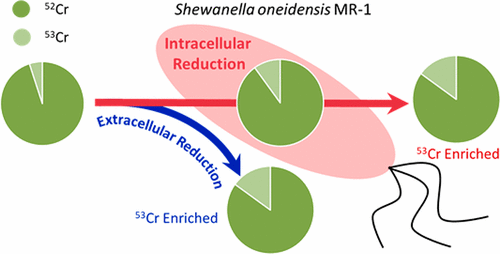当前位置:
X-MOL 学术
›
Environ. Sci. Technol. Lett.
›
论文详情
Our official English website, www.x-mol.net, welcomes your feedback! (Note: you will need to create a separate account there.)
Metal Respiratory Pathway-Independent Cr Isotope Fractionation during Cr(VI) Reduction by Shewanella oneidensis MR-1
Environmental Science & Technology Letters ( IF 10.9 ) Pub Date : 2017-11-02 00:00:00 , DOI: 10.1021/acs.estlett.7b00471 Jun-Cheng Han 1 , Guo-Jun Chen 2 , Li-Ping Qin 2 , Yang Mu 1
Environmental Science & Technology Letters ( IF 10.9 ) Pub Date : 2017-11-02 00:00:00 , DOI: 10.1021/acs.estlett.7b00471 Jun-Cheng Han 1 , Guo-Jun Chen 2 , Li-Ping Qin 2 , Yang Mu 1
Affiliation

|
Cr isotope fractionation during microbial reduction processes is commonly recognized as a promising tool in biogeochemistry and bioremediation. However, the mechanism of Cr isotope fractionation during microbial reduction is poorly understood. In this work, the relationship between the bacterial respiratory pathway and Cr isotope fractionation was investigated in Shewanella oneidensis MR-1. For comparison with the wild type, a mutant strain (ΔomcA/ΔmtrC) with a deficiency in extracellular Cr(VI) reduction was constructed by deleting the omcA and mtrC genes, which encode the terminal reductase during extracellular reduction. The magnitudes of Cr isotope fractionation (ε) for Cr(VI) reduction by the wild type and ΔomcA/ΔmtrC were −2.42 ± 0.68‰ and −2.70 ± 0.22‰, respectively. Surprisingly, the ε values were not significantly different between the two strains. This suggests that isotope fractionation is independent of the metal respiratory pathway during Cr(VI) reduction by S. oneidensis MR-1. Moreover, a three-step Cr isotope fractionation model that includes uptake, reduction, and efflux was proposed to exist during intracellular Cr(VI) reduction by S. oneidensis MR-1. The developed model provides a better understanding of Cr isotope fractionation during microbial reduction.
中文翻译:

拟南芥MR-1还原Cr(VI)时与金属呼吸途径无关的Cr同位素分离
微生物还原过程中的Cr同位素分级分离通常被认为是生物地球化学和生物修复中一种有前途的工具。但是,人们对微生物还原过程中Cr同位素分馏的机理了解甚少。在这项工作中,研究了印度希瓦氏菌MR-1中细菌呼吸途径与Cr同位素分馏之间的关系。用于与所述野生型,突变株(Δ比较OMC A /Δ MTR C)与细胞外的Cr(VI)还原的缺乏通过缺失构建的OMC A和MTRC基因,编码细胞外还原过程中的末端还原酶。铬同位素分馏(ε)为铬的大小(VI)还原由野生型和Δ OMC A /Δ MTR C组分别-2.42±0.68‰和-2.70±0.22‰。出乎意料的是,两种菌株之间的ε值没有显着差异。这表明同位素分馏过程不依赖金属呼吸途径,而被S.oneidensis MR-1还原Cr(VI)。此外,有人提出了一个三步铬同位素分馏模型,该模型包括摄取,还原和外排,这在拟南芥沙门氏菌MR-1还原细胞内Cr(VI)的过程中存在。开发的模型可更好地了解微生物还原过程中的Cr同位素分级分离。
更新日期:2017-11-02
中文翻译:

拟南芥MR-1还原Cr(VI)时与金属呼吸途径无关的Cr同位素分离
微生物还原过程中的Cr同位素分级分离通常被认为是生物地球化学和生物修复中一种有前途的工具。但是,人们对微生物还原过程中Cr同位素分馏的机理了解甚少。在这项工作中,研究了印度希瓦氏菌MR-1中细菌呼吸途径与Cr同位素分馏之间的关系。用于与所述野生型,突变株(Δ比较OMC A /Δ MTR C)与细胞外的Cr(VI)还原的缺乏通过缺失构建的OMC A和MTRC基因,编码细胞外还原过程中的末端还原酶。铬同位素分馏(ε)为铬的大小(VI)还原由野生型和Δ OMC A /Δ MTR C组分别-2.42±0.68‰和-2.70±0.22‰。出乎意料的是,两种菌株之间的ε值没有显着差异。这表明同位素分馏过程不依赖金属呼吸途径,而被S.oneidensis MR-1还原Cr(VI)。此外,有人提出了一个三步铬同位素分馏模型,该模型包括摄取,还原和外排,这在拟南芥沙门氏菌MR-1还原细胞内Cr(VI)的过程中存在。开发的模型可更好地了解微生物还原过程中的Cr同位素分级分离。



























 京公网安备 11010802027423号
京公网安备 11010802027423号